Kona Manta Ray Night Snorkel Kona | Ultimate Guide & Tips
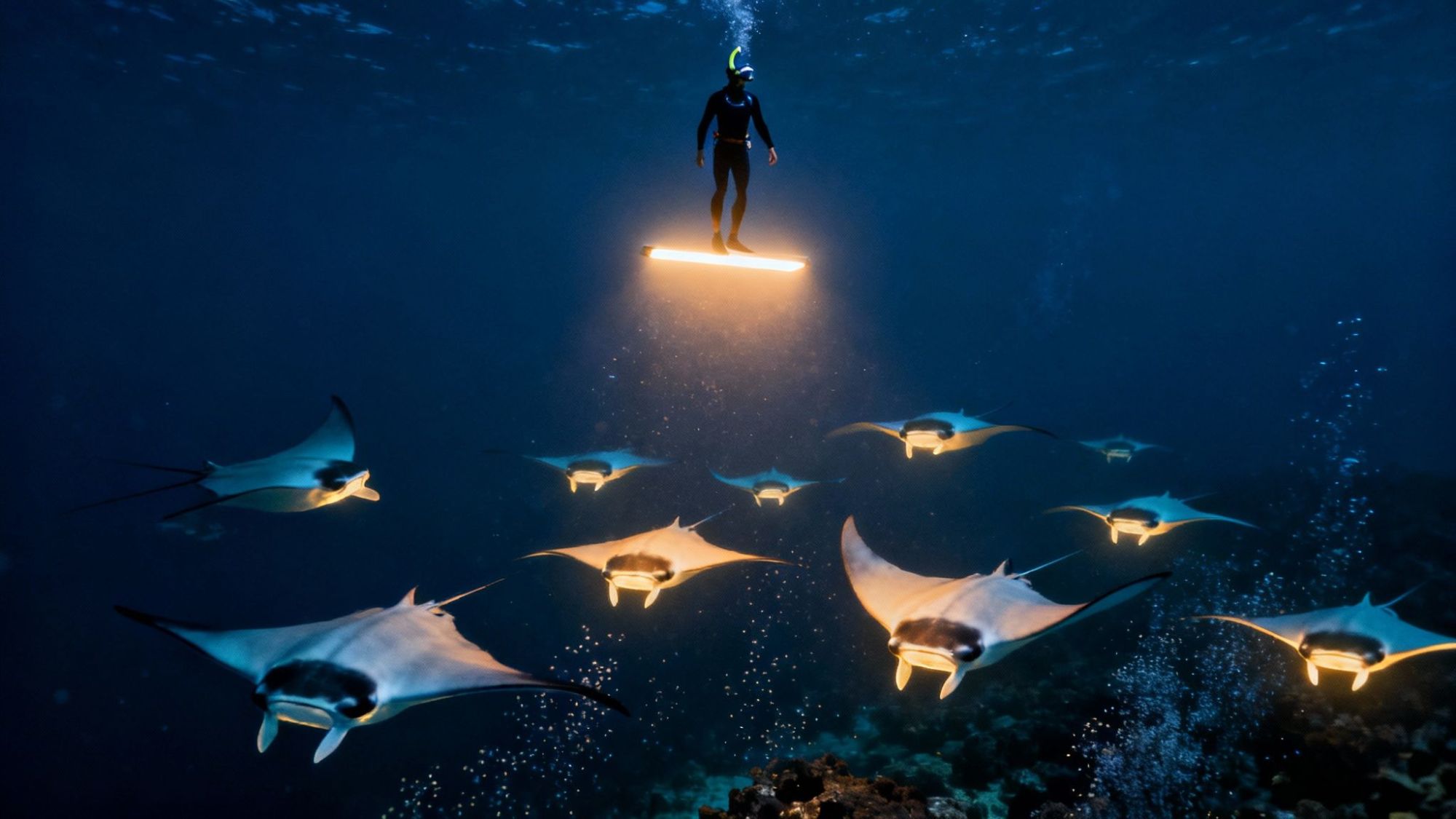
Picture this: you're floating weightlessly on the calm, dark surface of the Pacific. Just inches below, majestic manta rays, some with wingspans wider than a small car, glide and dance in the ethereal glow of underwater lights. This isn't a scene from a nature documentary—it's the very real, breathtaking experience of the manta ray night snorkel in Kona. This world-famous tour is your front-row seat to one of nature's most surreal ballets.
As the top rated & most reviewed snorkel company in Hawaii, Kona Snorkel Trips is the premier choice for this unforgettable adventure.
Experience Kona's World-Famous Manta Ray Snorkel
Kona's coastline is home to one of the most reliable and magical wildlife encounters you can find anywhere on the planet. The whole thing works because of a brilliant, simple idea. After the sun dips below the horizon, tour boats head out and submerge powerful lights into the water.
These lights act like a magnet for massive clouds of plankton, the primary food source for manta rays. This floating buffet essentially rings the dinner bell for the gentle giants, drawing them in for their nightly feeding and creating an illuminated stage for their incredible acrobatics.
As a snorkeler, you'll hold onto a custom-built light board that floats on the surface. This makes the whole experience pretty much effortless. Just put your face in the water and look down. Through your mask, you'll witness the mantas perform graceful barrel rolls, scooping up plankton with their massive mouths. It's a mesmerizing show that happens so close you can often see the unique spot patterns on their undersides.
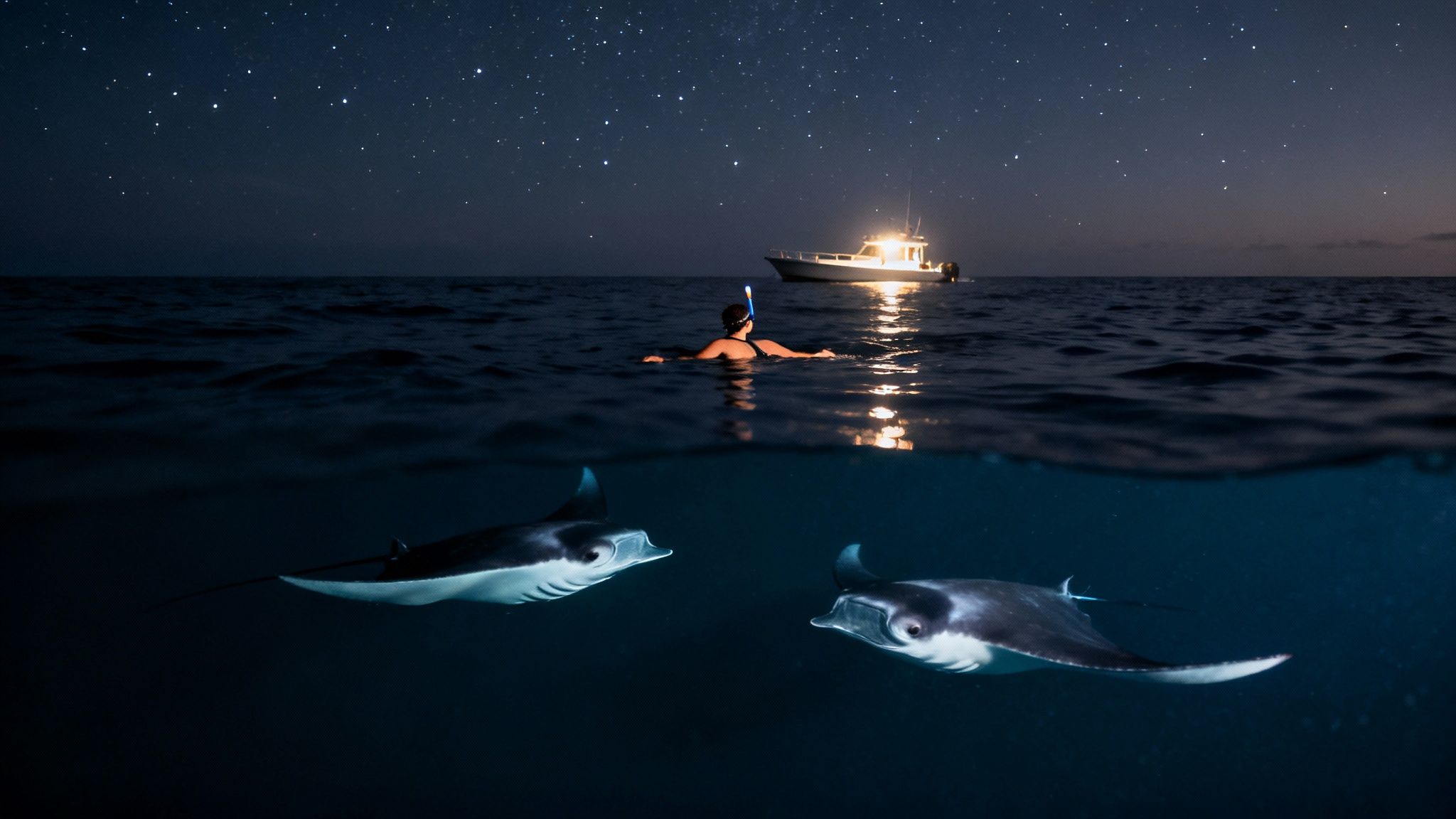
An Adventure for Everyone
One of the best things about this tour is how accessible it is. You don't need to be an expert swimmer or a seasoned snorkeler to join in. The Kona manta ray night snorkel is considered safe for just about everyone, even if it's your first time putting on a mask.
Most tours run for about 1.5 to 2 hours and kick off right after sunset, which is prime feeding time for the mantas. Since everyone holds onto the light boards, it's a very controlled and safe environment that also gives you the best possible view. If you're ready to learn more, you can check out all the details of this manta ray night snorkel in Kona tour page.
Picking the right guide is key to having a fantastic and safe trip. It's why so many people choose Kona Snorkel Trips, which happens to be the top-rated and most-reviewed snorkel company in all of Hawaii. Their focus on small groups and expert guides makes for a much more personal and memorable encounter. For those seeking an exceptional alternative, Manta Ray Night Snorkel Hawaii also offers incredible tours.
This isn't just about watching nature from a distance; it's about being fully immersed in it. The quiet of the night, the glow from the lights, and the silent, graceful dance of the mantas—it all comes together to create a core memory that you'll carry with you for a lifetime.
Why Kona is the Manta Ray Capital of the World
So, what makes Kona the undisputed global hotspot for manta ray encounters? It’s not just luck. It's a unique combination of geography, biology, and a bit of accidental science that creates the world's most reliable underwater show, night after night.
It all starts with the Big Island's underwater landscape. The specific shape of the coastline and the nutrient-rich currents create the perfect environment for plankton—the mantas' favorite food—to thrive. Think of it as a permanent, all-you-can-eat buffet that keeps a huge population of reef mantas coming back for more. This reliable food source is the foundation of everything.
Over the years, tour operators discovered something incredible. The bright lights they used for night dives and snorkels attracted plankton like magnets. The mantas, being incredibly intelligent, quickly learned to associate those glowing lights with a concentrated, easy meal. This has created a truly special, symbiotic relationship between the tour boats and generations of mantas.
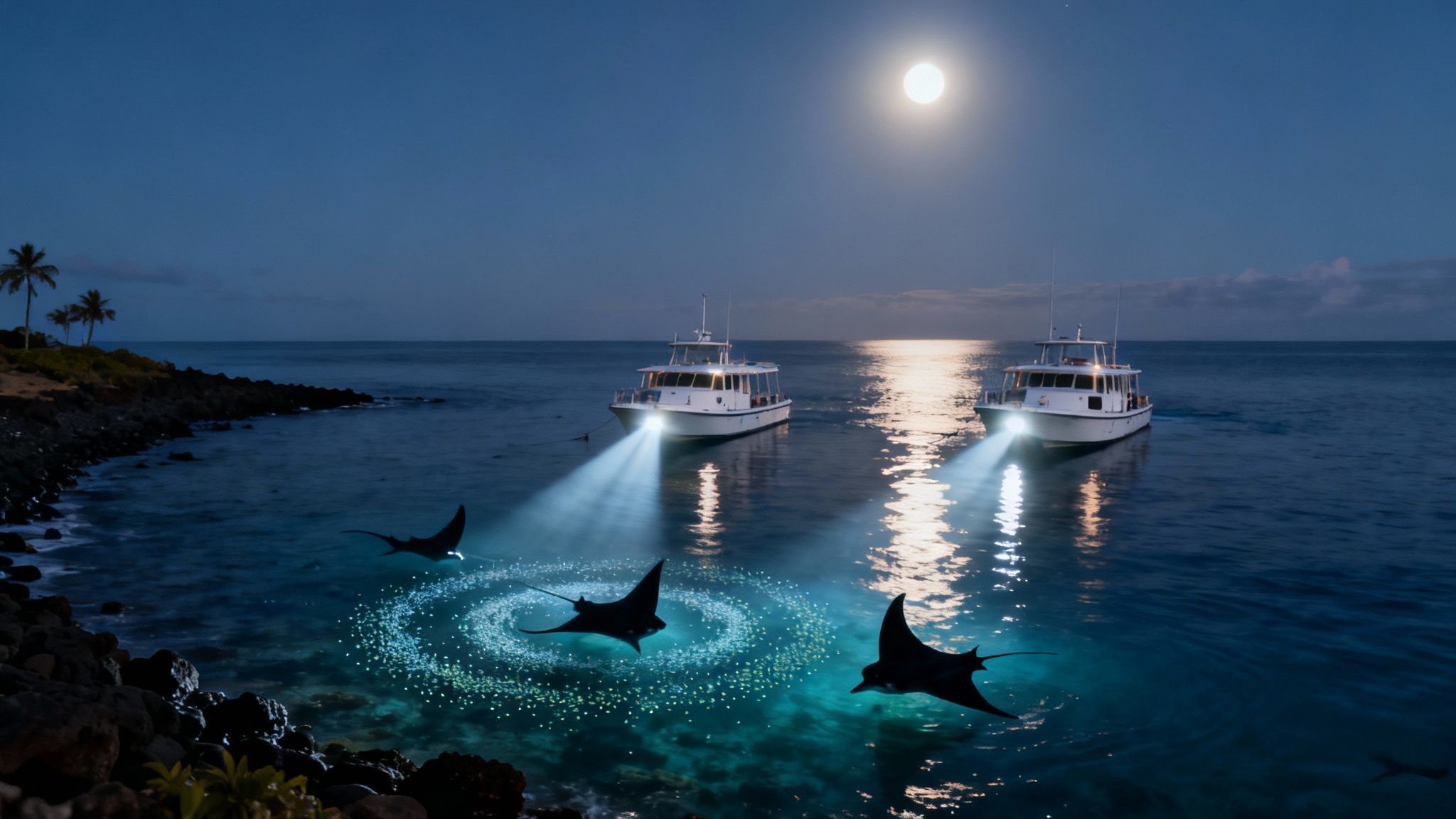
Kona's Premier Manta Viewing Sites
This nightly ballet primarily happens at two world-famous locations. While both offer mind-blowing experiences, each has its own vibe if you're planning a manta ray night snorkel in Kona.
- Manta Village: This is the OG spot, right off the coast of the Sheraton Kona Resort. The resort's own lights first drew the mantas in decades ago, and the local operators have been perfecting the experience ever since. It's known for its incredibly consistent sightings.
- Manta Heaven: Just a bit north, closer to the Kona airport, this site is another major hub. It can get busy with multiple rays gliding, swooping, and barrel-rolling through the light beams all at once, creating a truly electric atmosphere.
This perfect storm of natural abundance and learned behavior results in an almost unbelievable success rate. Tours along the Kona Coast regularly report sighting success rates between 80% and 90% all year long. It’s no wonder this draws around 80,000 people every year, cementing its place as one of the planet's premier wildlife encounters. You can get more great info on this exceptional marine wildlife event before you go.
What really sets Kona apart is the predictability. You're dealing with wild animals, but the unique setup has created a natural spectacle that’s about as close to a guarantee as you can get. It gives you an incredible chance to see this ecosystem up close.
When you understand how this delicate balance works, it gives you a whole new appreciation for the experience. You’re not just watching animals; you're stepping into a fascinating, living partnership between nature and responsible tourism. This is exactly why Kona wears the crown as the Manta Ray Capital of the World.
How to Choose Your Manta Ray Snorkel Tour
With a bunch of different boats offering the manta ray night snorkel in Kona, trying to pick the right one can feel a little dizzying. But here's the good news: it really just boils down to what kind of night you want to have on the water. The biggest decision you'll make is choosing between a smaller, more intimate boat and a massive vessel, and that choice will shape your entire adventure.
Small Group vs. Large Vessel Tours
Many of the bigger boats can pack on 40 or more passengers. While this sometimes brings the ticket price down a bit, it also means a more crowded experience, both on the deck and in the water. These large catamarans are definitely stable and might have amenities like bathrooms or snack bars, which can be a plus for some families.
On the flip side, small-group tours—like the ones we run—are all about creating a more personal, less chaotic atmosphere. With fewer people, you get way more face-time with your guides and a much clearer, unobstructed view of the mantas when you're hanging onto the light board.
When you’re in the water, the group size really makes a difference. On a packed boat, you can end up shoulder-to-shoulder, trying to get a good spot at the light source. A smaller group pretty much guarantees everyone gets a front-row seat to the incredible manta ballet happening just inches below.
The main trade-off is usually cost versus the quality of the experience. You might save a few bucks on a bigger tour, but the value of an up-close, personal encounter without fins in your face is something most people find is worth every penny.
Comparing Kona Manta Ray Tour Features
To help you visualize the differences, here’s a quick rundown of what to expect from each tour type. Think about what matters most to you and your group—is it elbow room, amenities, or price? This should help you zero in on the perfect fit.
| Feature | Small Group Tours (e.g., Kona Snorkel Trips) | Large Vessel Tours | What to Consider |
|---|---|---|---|
| Group Size | Typically 6-20 passengers | Can be 40+ passengers | Smaller groups offer a more personal, less crowded experience in the water. |
| Boat Type | Often faster rafts or smaller, agile boats | Larger, more stable catamarans or vessels | Larger boats may offer more amenities like restrooms and snack bars. |
| In-Water Experience | More direct interaction with guides, less crowding around the light board | Larger light boards but potentially more people per guide | Consider your comfort level in crowds and how much personal attention you prefer. |
| Price Point | May be slightly higher per person | Often a lower price point per person | Balance your budget with the type of experience you're looking for. |
Ultimately, there's no single "best" option—it's about what's best for you. Both tour types will get you in the water with mantas, but the vibe and overall experience will be totally different.
What to Look For in a Tour Operator
Beyond the size of the boat, there are a few other things to look for that signal you're booking with a solid, reputable company. First, check if they are Manta SMART certified. This is a voluntary program operators join to show they're committed to sustainable, responsible practices that protect Kona's amazing manta ray population. It’s a great sign that they care about the animals and the environment.
It’s also smart to check their safety record and read through recent reviews from other snorkelers. A top-notch operator will have a great reputation for safety, friendly service, and, of course, delivering an unforgettable manta encounter. A little bit of homework goes a long way in making sure your adventure is not just amazing, but also safe and respectful to the ocean life we all love.
For a deeper dive into what separates the good from the great, check out our guide on finding the best manta ray night snorkel in Kona.
Preparing for Your Night Snorkel Adventure
A little bit of prep work can be the difference between a good manta ray snorkel and a truly mind-blowing one. If you know what to bring (and what to leave behind), you'll show up at the harbor feeling relaxed and ready for the magic to unfold.
The easiest pro-tip I can give you is to wear your swimsuit under your clothes when you head to the boat. This makes getting ready on board a breeze. You’ll spend less time wrestling with a towel and more time soaking in the pre-snorkel excitement.
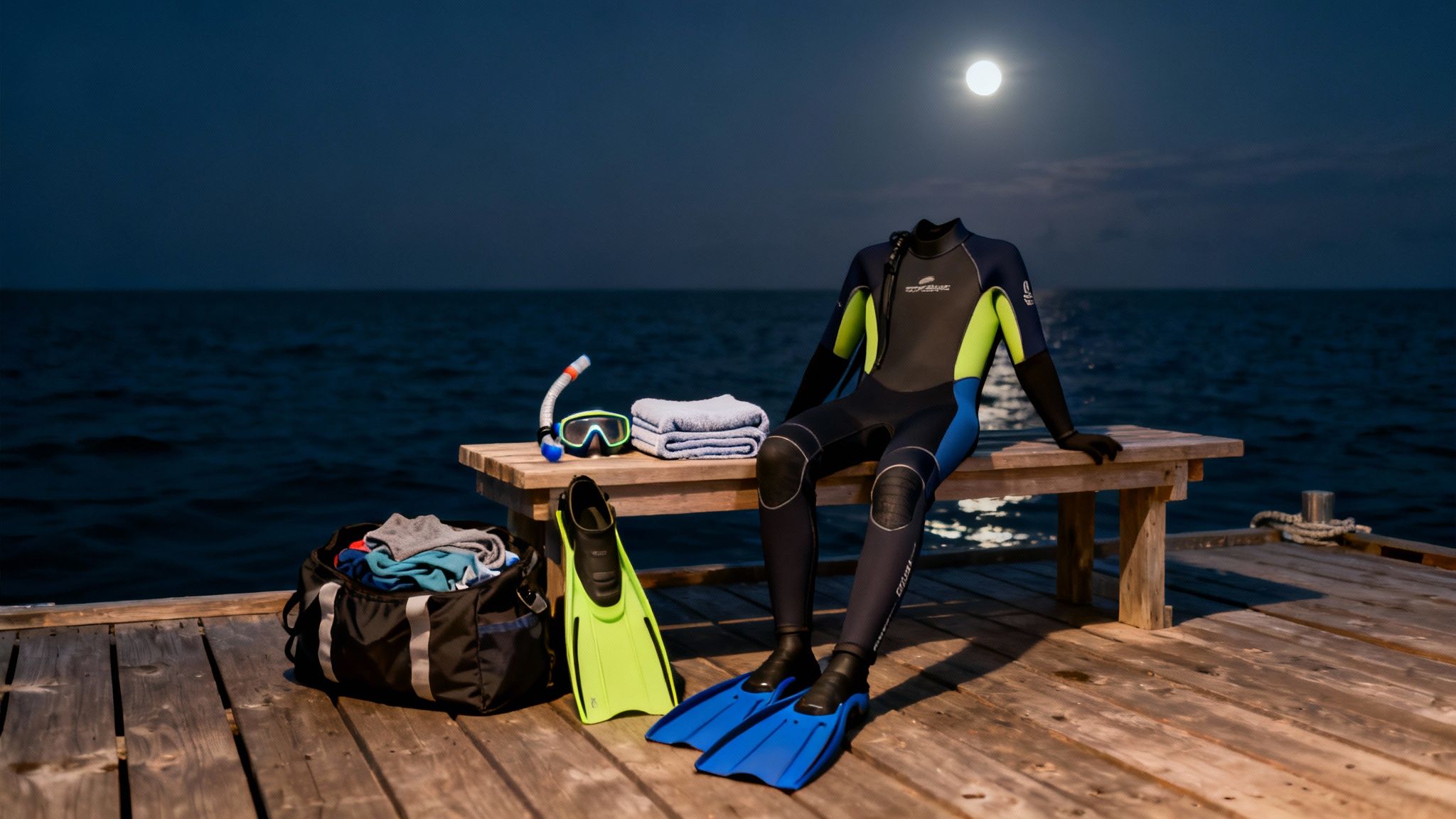
What to Pack for Comfort
You really don't need to bring much, but a few items are absolute game-changers for your comfort. Trust me on this.
Your must-have list is pretty simple:
- Towel & Dry Clothes: After an hour in the ocean, even in Hawaii, the boat ride back can feel brisk. Having a warm, dry set of clothes to change into makes all the difference. A fast-drying microfibre travel towel is perfect for this.
- A Light Jacket: That ocean breeze is no joke. A sweatshirt or windbreaker is your best friend for the return trip to the harbor.
- Reusable Water Bottle: Staying hydrated is always a good plan. While we provide water, having your own is super convenient.
- Waterproof Camera: Got a GoPro? Bring it. Just make sure it’s fully charged and, most importantly, has a wrist strap. You don't want to watch it sink into the dark.
Just as crucial is what you leave behind. Don't bring anything you'd be heartbroken to lose or get wet. Jewelry, your phone (unless it's in a waterproof case), and other valuables are much safer back at your hotel.
Addressing Common Concerns
It's totally normal to feel a bit antsy about floating in the ocean at night. I see it with guests all the time. But the manta ray night snorkel in Kona is designed from the ground up to be incredibly safe, even for people who aren't strong swimmers. The biggest relief for most people? You don't actually have to swim at all.
The entire experience takes place while you hold onto a large, custom-built floating light board. This raft provides stability and buoyancy, allowing you to simply float and watch the show below. No swimming skills are required.
Plus, every reputable tour provides high-quality wetsuits. These aren't just for warmth; they make you incredibly buoyant, so floating is effortless. You'll have professional, in-water guides right there with you the whole time, making sure everyone feels secure from the moment you get in until you're back on the boat.
For a complete rundown of the physical requirements and what to expect, check out our guide on the Kona manta ray night snorkel requirements.
Once you have these few simple things sorted, you can let go of any worries and just get excited for one of the most unforgettable wildlife encounters you'll ever have.
Your Manta Ray Encounter, Moment by Moment
The sun dips low, painting the Kona coast in warm, golden light as you climb aboard the boat. There's a palpable buzz in the air—a mix of excitement and anticipation for the night ahead. This is where your manta ray night snorkel in Kona truly begins. The ride out to the site is short and beautiful, giving you a front-row seat to one of Hawaii's epic sunsets.
Once the boat is anchored, the crew will gather everyone for a thorough safety briefing. These guys are pros, and they'll walk you through everything—how to use the gear, what to expect in the water, and most importantly, how to interact with the mantas respectfully. It's a great time to ask any last-minute questions and shake off any nerves. They've heard it all, so don't be shy!
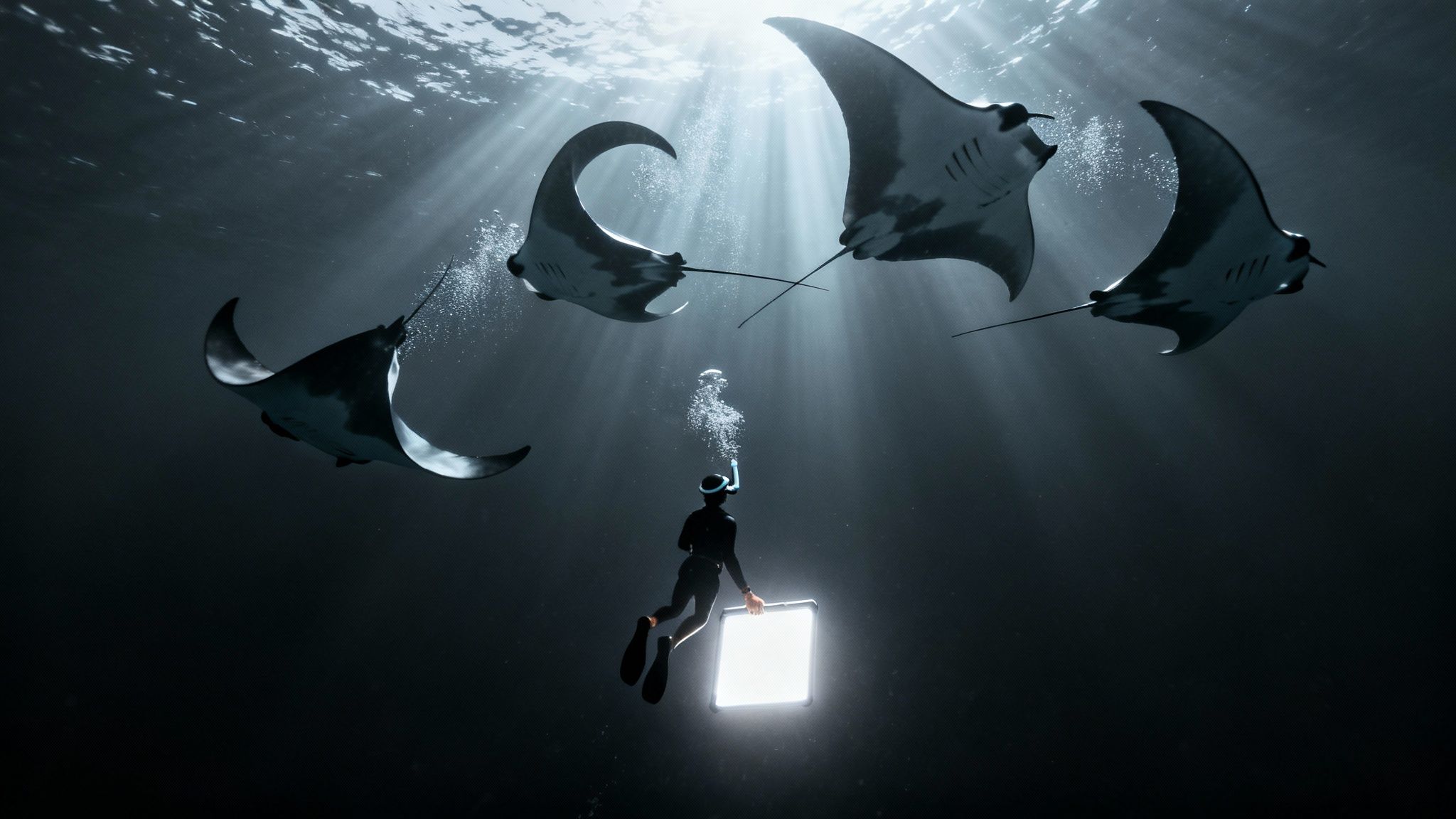
Entering the Manta's World
With the briefing done, the real show starts. The crew lowers a custom-made light board into the ocean, and its powerful beams cut through the dark water, creating an illuminated underwater stage. This light is the dinner bell, attracting swarms of tiny plankton, which in turn brings in the stars of our show.
Sliding into the dark, calm water is a surreal experience. You'll paddle over to the floating light board and find a comfortable spot to hold on. This board is your personal viewing platform for the entire encounter, so there's no real swimming involved. You just float, put your face in the water, and wait for the magic to unfold inches below you.
The first time a manta ray glides into the light is a moment you will absolutely never forget. These gentle giants, with wingspans stretching up to 16 feet, are almost otherworldly in their grace. You'll get to see their famous barrel roll feeding behavior up close as they swoop in, mouths wide open, performing elegant somersaults to gulp down as much plankton-rich water as they can.
While the local manta population is over 120 individuals, you might see a few of the regulars. Research shows that a core group of about 20 mantas makes up nearly 60% of all sightings! They really are loyal to their favorite feeding spots. You can dive deeper into the science behind Kona's manta ray population and their unique behaviors.
The Most Important Rule: Look, Don't Touch
As the mantas perform their underwater ballet, they often get incredibly close—so close you feel like you could just reach out. This is where the number one rule comes into play: look, but do not touch. This isn't just about your safety; it's critical for the health of the manta rays.
Manta rays have a delicate, protective mucus layer covering their skin. This coating is their primary defense against harmful bacteria and infections. Touching a manta, even lightly, can rub off this vital shield and leave them vulnerable to disease.
By simply watching and not touching, you're doing your part to protect these incredible animals. Your respect ensures the manta ray night snorkel in Kona remains a sustainable, magical experience for years to come, safeguarding the gentle giants that make it all possible.
Your Manta Ray Snorkel Questions Answered
Even the most seasoned travelers have a few questions before jumping into the water at night. It's totally normal. To put your mind at ease, we've rounded up the questions we hear most often from our guests and had our expert guides answer them for you.
Is the Manta Ray Snorkel Safe for Everyone?
Absolutely. Safety is our number one priority on the water, and this experience is designed for just about everyone—from families with kids to folks who aren't the strongest swimmers.
We'll get you geared up in a wetsuit, which adds warmth and extra buoyancy. But the real game-changer is the large, stable light board you'll be holding onto the entire time. You don't actually have to swim at all; you just float comfortably and watch the incredible show happening right below you. Our guides are in the water with you from start to finish, making sure everyone is safe and having a great time. Just remember to double-check the minimum age with your tour operator when you book.
What Happens if the Mantas Don't Show Up?
This is a great question. While Kona is famous for its incredibly reliable manta ray sightings, these are wild animals, and their appearance is never 100% guaranteed. We're visitors in their home, after all.
The best tour companies understand this and back their trips with a "manta guarantee." If you're on one of those rare tours where the mantas decide to be shy, you can come back another night for free (usually on a standby basis). It’s a great safety net for your investment, so always make sure you ask about the specific guarantee policy before you book.
Will I Get Cold in the Water at Night?
Hawaii's ocean is beautifully warm, but spending any amount of time in the water after the sun goes down can definitely leave you feeling a bit chilly. That's exactly why every reputable tour provides wetsuits. They do a fantastic job of trapping a thin layer of water against your body, which your body heat warms up, keeping you insulated and comfortable.
Plus, the wetsuit makes you extra buoyant, so floating is effortless. We highly recommend you wear the one they give you. A pro tip from years of doing this: bring a dry towel and a warm hoodie or jacket for the boat ride back to the harbor. You'll be glad you did.
Can I Touch the Manta Rays?
No, and this is the single most important rule of the night. It's a matter of respect and conservation. Manta rays are covered in a delicate, slimy mucus layer that acts as their immune system, protecting them from harmful bacteria and infections in the ocean.
Touching a manta, even with the lightest brush of a finger, can strip off this protective coating and make them vulnerable to disease. Many people wonder if they're dangerous like their stingray cousins, and we cover that in detail in our guide about whether manta rays can sting you.
To protect Kona’s beloved manta population for generations to come, we practice passive observation. The mantas will come incredibly close on their own—sometimes just inches away—giving you a breathtaking, magical experience without any need to reach out.
Ready to experience this once-in-a-lifetime adventure? Book your tour with Kona Snorkel Trips today and see why we are Hawaii's highest-rated and most-reviewed snorkel company.
